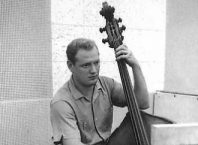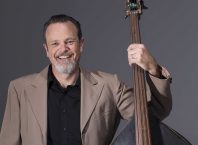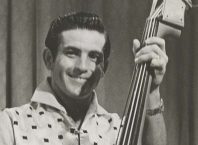After putting Atomic Boogie, my promo video at the time, on YouTube, I began receiving a lot of emails from fellow slap bassists. The email that stood out the most was sent to me by French bassist Nicolas Dubouchet.
From the email, I immediately noticed that Nicolas and I share a passion for the playing of another great slap player – Gilles Chevaucherie. I was especially interested to hear Gilles’ early recordings, so Nicolas mailed me a CD. He also modestly sent me a few recordings of his Rockabilly band Charlaz. I was immediately blown away by his technique and musicality, but what impressed me the most was his unique style. I had to wonder why no one ever talks about this guy, considering his great chops and sound. As a matter of personal taste, he happens to have recorded one of the best versions of “Big Noise from Winnetka” that I’ve ever heard!
Over time, Nicolas and I stayed in touch and become good friends. I’m proud to present to you here, on the Art of Slap Bass, for the first time ever:
NICOLAS DOUBUCHET
Djordje: Salut Nicolas!
When did you start and what inspired you to play double bass?
Nicolas: Hi Djordje!
I started when I was about 12 years old, and because of two big events. First, during my summer holidays I used to see traditional jazz band named “Les Haricots Rouges”. At first I was into trumpet but when I heard a big slap solo on doubIe bass I realized that was it! Second, the first album I bought was the first Stray Cats record. Then it got under my skin. My parents bought me an electric bass, but I put a big stick on it’s bottom and played it as a stand up bass. After a year and a half of little work, I was able to buy a real one. I was about 14 back then.
Djordje: How did you learn to play?
Nicolas: The rock’n’roll way! I mean, I’ve never taken any lessons because no one was able to teach slap in my little town back in those years. I learned by listening records with friends, trying to reproduce them. Gene Vincent, Bill Haley, Elvis… I found a Memphis Slim & Willie Dixon record in my old aunt’s house. What a fortune! It was impossible to find any instructional videos in France during the 80’s. The first one I saw was Lee Rocker’s in 1998.
Djordje: What are your instruments?
Nicolas: I got two Engelhardt EM1s. I’m a big fan of Kay double basses, but I think I will never have the chance to play a vintage one, because I’m left handed. If anyone knows anything about old lefty Kays, please contact me! The first bass I got was Favino and later a Rubner, but that wasn’t the sound I was looking for. Engelhardt made me a real left handed one and I’m very happy with it.
Djordje: You’ve been using weed wacker strings for a long time now. How do you keep them in good shape and what are the advantages of those strings over the others in your opinion?
Nicolas: I played steel strings for a long time with magnetic pick-up and piezo under the fingerboard for the “click”. It had a very big sound, but not the real acoustic one. Above all, I was looking for the slap sound from my old records. So, as I started to play much more acoustically I decided to make a change. I tried a lot of strings with the help of my friend Ivan Souverain (The Backleg Breakers) and finally put these weed wacker strings on my bass. It wasn’t easy! These strings were green and flubby, but sound like I want them to. We did a lot of experiments with different chemicals on them and found a secret to solve those problems. Now I got a good tension, a big sound and nice gut tone that I like. I play guts sometimes, but I have to take very good care of them. My weed wackers are unbreakable, they stay in tune and they’re very cheap. These days I’m trying something new. I put an A Pirastro Oliv’ detuned to E and It works pretty good. That’s a good solution for the E string problem that weed wacker and gut strings have. I would like to thank Pirastro for their contribution.
Djordje: What came first, pizzicato or slap and how did you learn the slap technique?
Nicolas: Slap came first. I was immediately fascinated with it. As I already said, I learned by listening records. I was lucky to live during the 80’s rockabilly revival here in France. During that era there would sometimes be a rockabilly band on TV, but you know, the camera was much more on the leopard-creepers than the hands of the bassist! At that time, I didn’t have a VHS recorder, so I had to remember as much as possible and try to imitate it afterwards.
Djordje: I noticed that historically there is a lot of confusion about names for different slap patterns (read more about it here). I personally prefer to count both slaps of the string and the palm. Some people count just slaps of the palm. What are the names that you use and what kind of different slap patterns do you use in your playing?
Nicolas: I agree with you. When I slap a bass just with the fingers, I call it a “simple slap”. “Double slap” when I hit the fingerboard with the palm once between two notes, a “triple slap” (or triplet) when I hit it twice between the notes, a “quadruple slap” for three palm hits between the notes and a “drag slap” for the kind of a quick triplet. I use all these patterns in my playing plus the one I named a “pull-slap”. It’s a kind of a drag slap with an open G that adds a velocity effect. I also use a pattern that I call “quadruple drag” that starts with the back of my pinky, then I use thumb and the palm at the end. Always experimenting…
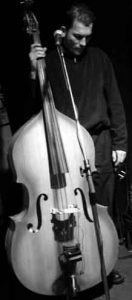 Djordje: Who are your slap influences?
Djordje: Who are your slap influences?
Nicolas: My slap influences are the same as for many other slap players:
Willie Dixon – we got a live CD here in France “Live aux Trois Maillets” with Memphis Slim, where you can hear Dixon perhaps at his best.
Slam Stewart – I like his easy and lazy way of playing, specially with Slim & Slam.
Bob Haggart – for his version of “Big Noise from Winnetka”.
Milt Hinton – like everybody!
For blues: Ransom Knowling and Ernest Crawford.
Louis Vola – his duo with Django “You, Rascal You” is a very good example for his playing.
I think I missed someone… but, generally speaking, I like this whole era. I also like New Orleans jazz slappers.
Djordje: Do you like any other slap players nowadays?
Nicolas: Yes, sure! Jimmy Sutton plays in a pretty good vintage way. Kevin Smith and Beau Sample are very good in the Texas style. I like Mark Winchester’s work with the Brian Setzer Orchestra. There is also a guy who has a big solo on YouTube called “Atomic Boogie”…do you know him?
I like very much the way Vlad Viorel slaps in the Balkan style. I have seen some Eastern European guys with three strings basses that are very good, but I don’t know their names. In France we have a guy named Gilles Chevaucherie who has a pretty unique technique and had a chance to play with Memphis Slim and Slim Gaillard among others.
Djordje: You’re the only guy that I ever met who is as big fan of Gilles Chevaucherie as I am. Is slap bass tradition strong in France?
Nicolas: It depends on the style of the era. During the eighties, every village had their rockabilly band with a slapper. Nowadays a slap upright bassist is more like an UFO! I’m kidding, but it is almost like that. In the eighties, there were many slappers in New Orleans jazz style as well.
When other bassists see a slapper, they want to slap too. They often don’t even start, because of the adjustment of their instruments. The problem they meet is the height of the strings. I think that it shouldn’t be a problem – look at Milt! As a conclusion, you either play be-bop or rockabilly, nothing in between. Anyway, nowadays in France, you can see slappers in New Orleans jazz style and in rockabilly bands that still exist.
Djordje: In the last few years, I had a chance to play all the Djangofests in the US and one thing I noticed is that bassists never use slap. That was a bit of a surprise for me, because Luis Vola (Django’s original bassist and the guy that discovered him) as well as Tony Rovira, played slap on a regular basis. Nowadays it seems that short pizzicato sound has become the stylistic way of playing Gypsy Jazz. This music genre originates in France, so it would be interesting to hear your opinion about it.
Nicolas: It is the same thing here and in the entire Europe, I think. In fact, bassists are getting better and better. Sometimes they even play like guitarists and forget what their place in the band is. I don’t want to ever forget that I am an accompanist. Slam Stewart’s playing on the album “Fish-scales” is a very good example. Every time after his fantastic bow job (ha,ha), he plays pizz in a very simple way, just enough that other musicians hear the chord progression. That’s what the job of the bassist is for me. We are accompanying and sometimes soloing, but not both at the same time. Our duty is to make the song swing with or without slapping. That’s my opinion, but perhaps I’m a “has-been” and too much old-fashioned! Anyway, we have to be careful with slap in jazz music. We have to slap more quietly in order not to disturb a soloist.
Djordje: Who are you playing with these days?
Nicolas: I’ve been playing with my band “Charlaz” for ten years. It’s a kind of a rockabilly trio. I mean it’s not pure rockabilly, because we add other things we like in our music. We are currently recording our fifth album. I also play with “Sweet-Dixie”, a vintage swing jazz band. The first album is coming out soon. I play blues with the association named “Marine-Band-Club” (most of the time with Anthony Stelmaszack on guitar and vocals) and Rockabilly with guitarist and singer Francky Gumbo. I also play Gypsy Jazz with the quartet “Swing 33” and guitarist Geoffroy Boizard.
Djordje: How do you like to record your bass?
Nicolas: I used to record myself in my home studio with an Audio-Technica AT4033A that I’d put about 50cm (20”) from the bridge. It makes a good combination of a good bass tone and slap. For my DVD I used a Rode tube mic for the whole band. I think that sounds better, but it’s not mine! I record acoustically, I never use an amp or a pick-up on my recording sessions. My dream is to try one day the Western-electric mic Willie Dixon used.
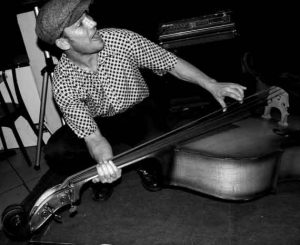 Djordje: I’m glad you explained Dixon’s way of playing a quadruple slap (the one that can be heard on Memphis Slim’s “Rockin the House” and many Big 3 Trio songs) on your DVD. Your way of playing it sounds the closest to the man as I ever heard. Our readers can hear it here on “Dixon’s Boogie” as well. How did you come up with playing that way?
Djordje: I’m glad you explained Dixon’s way of playing a quadruple slap (the one that can be heard on Memphis Slim’s “Rockin the House” and many Big 3 Trio songs) on your DVD. Your way of playing it sounds the closest to the man as I ever heard. Our readers can hear it here on “Dixon’s Boogie” as well. How did you come up with playing that way?
Nicolas: It took me a lot of time. In the 90s I was able to play all the other slaps, but not the Dixon’s quadruple. I had many records with that riff in his solos, but no videos, so I had to imagine once again… In order to hear all details I slowed it down with a tape recorder and that’s when I really heard “poum, pa pa pa, poum”. At that point I was really sure that was a bass slap and not a “slap-box” like it was mentioned on some roots records. Then I was looking for better way to play three slaps between two notes with this velocity. Doing that I discovered another quadruple and a quadruple drag that I will explain on Slapology vol2. So, one night, I woke up and said “Eureka!”. It’s just 2 double slaps with second tone muted! To be clear, you have to play 1-2-3-4, 2-2-3-4 etc (1 is actual note/tone, 2 and 4 are the slaps/hits, 3 is played like a note, but muted with left hand). It’s very important to play the same attack on each slap. That’s why I slap on the same place of the fingerboard. I think that the explanation is much more clear on the DVD.
Djordje: I enjoyed watching your instructional DVD very much. You plan to do another one?
Nicolas: Yes, I think I will record Slapology vol2 next year. I will assume that everybody who buys it already knows how to play every slap pattern I explained in the vol1. And then I’ll start to explain how to build solos in different styles: swing, gypsy jazz, rockabilly, trad jazz etc and how to accompany the soloist. The first DVD is just about slap technique. I will explain two other ways of playing a quadruple as well. This time I’ll make sure that there is a version in English!
Djordje: What songs that you recorded would you recommend to bass players that are interested in your slap technique?
Nicolas: You can hear “Slapology” and “Stray Cat Strut” on the Charlaz album “Alive & a live” or you can watch “Avalon” and “Dark Eyes” on my myspace page and YouTube. I also play some solos on upcoming Charlaz and Sweet Dixie records. And of course “Dixon’s Boogie” that I recorded specially for you and “The Art of Slap Bass”.
Djordje: Are there any touring plans outside of France?
Nicolas: I haven’t played abroad at all in the recent years. I’m busy playing French west-coast and my daughter also needs her daddy! There are no plans for touring outside of France in the near future, but we would like to do it someday.
Djordje: What are your preferences for amps and pickups?
Nicolas: I play with an Ampeg B2 head plugged in a Fender 15″ cab. My pickup is a vintage Barcus Berry named “the Clamp”. It’s very easy to install it and it has no feedback at all! I think that’s enough for clubs. On the bigger stages I use the same gear and I also send a signal to the PA. When I play jazz or gypsy I don’t use amp, just a regular Shure SM58 or 565 fixed on the bridge. That’s better way to keep a natural sound. If I don’t have my mic with me, I use what ever the engineer gives me.
Djordje: What do you suggest to younger players to practice on a daily basis?
Nicolas: First, a big coffee with or without iodine in it. Then they should try to play very simple stuff in all keys. Blues is a good example. They can try to improve it with different substitutions once they feel more comfortable with it. This exercise is kind of a warm up. You are practicing and warming up at the same time. While changing the keys, they should also try to explore the whole fingerboard, even if they don’t use it on stage. For the slap technique it is very important to use a metronome and not lose the beat. Play a bass line with pizz and then slap it. After that, try to add double, triple and quadruple slap. You can also mix them all in the same bass line. Try to reproduce the riffs you like on your favorite records and create some new ones as well.
Djordje: Thank you for finding time to do this interview and hope to see you play sometime soon!
Nicolas: I thank you and Rockabillybass.com for making slap bass more popular.
Nicolas Dubouchet Official Myspace Page
If you want to ask Nicolas Dubouchet a question, you can do that on our forum.


